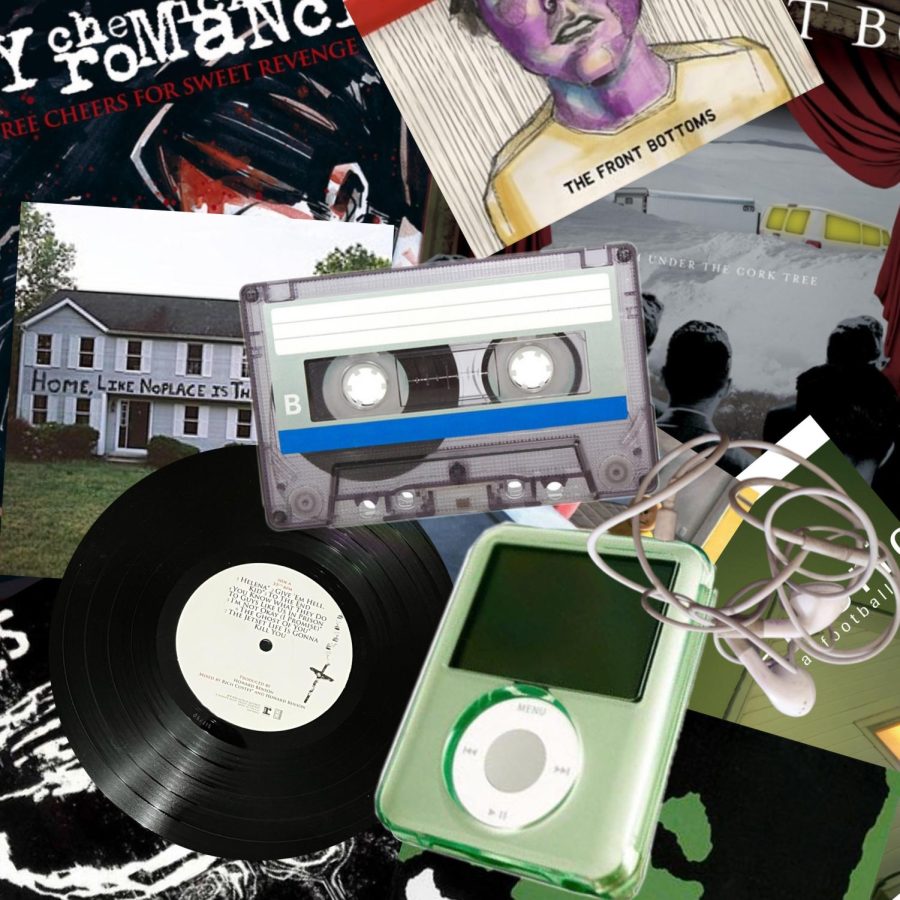Waves Of Emo Crash Through The Decades
December 16, 2022
Other articles in this series: How Grunge Changed Music Forever
Most people know emo as the insult that we call people who wear all black, eyeliner, or/and spiked collars, but like the lyrics of your favorite Sunny Day Real Estate song, emo as a subculture goes way deeper than that. Emo was started in Washington D.C.’s post-hardcore punk scene in the 80s, even before the word “emo” was spoken.
There are many waves of emo, and they changed a lot throughout time. The first two waves are important because they are so influential to modern-day emo and other subcultures. The third wave is what we picture when we see emo. The fourth wave is a comeback of the second wave, which has caused a spike in popularity.
1st and 2nd Wave Emo
Emo, or emocore, is short for emotional core, a subgenre of post-hardcore punk. Emerging in 1985, the scene was most popular in Washington D.C. Post-hardcore punk was getting too violent and political for some people, so those people created a more intrapersonal, woeful subgenre: Emocore.
The origin of the term “emo” is unknown, but we know it was coined sometime in the mid-80s in Thrasher Magazine’s January edition in 1986; the term “emo” was never accepted in the subculture though. Bands like Embrace would embrace the genre’s sound and culture but never the name “emo.” The word “emo” was made to poke fun at the subculture; the insult was used to call someone “feminine” or “sensitive.”
Emocore was a subgenre of post-hardcore, but it left the angry and aggressive sound out. Personal, emotional lyrics mixed with melodic guitars became the groundwork for this genre. At live performances, some audience members would cry because the songs were so relatable. Bands like Rites of Spring, Gray Matter, and Embrace were pioneers of this melodramatic child of post-hardcore.
The early emo style was nothing like what you would see in two decades. Emos wore cuffed jeans, sweaters, vintage T-shirts, Chuck Taylors, and geeky glasses, something you would expect a stereotypical nerd to wear today.
In the ‘90s, emo spread to the midwest, creating a one-of-a-kind genre: midwest emo. This subgenre took some of the aggressive post-hardcore out of emo and added a more indie, math rock sound, with deeper and even more woeful lyrics.
Some well-known bands in the subgenre are Sunny Day Real Estate and Jimmy Eat World, which are both credited as influential to the emo subgenre.
Although midwest emo was naturally popular in the midwest, it wasn’t exclusive to midwestern states. For example band, Sunny Day Real Estate was formed in Seattle, Washington.
Many people may get midwestern emo mixed up with math rock. This branch of rock is called math rock because most music uses a 4/4 time signature, bands in this subgenre frequently change to less traditional time signatures like 11/8 or 5/4, creating a mathematical-like rhythm. Bands like TTNG and American Football are examples of this musical subgenre.
3rd Wave Emo
In the ‘00s, emos evolved once again, but this time it added this hair metal, pop-like sound to it. The genre was still angry and full of speed, but it was softer than the post-hardcore scene in the 80s.
The subculture had three big bands at the time: My Chemical Romance, Panic! At the Disco, and Fall Out Boy. These would later be called on Tumblr, “The Holy Emo Trinity.” People went crazy over these groups and still do.
My Chemical Romance (MCR) was formed in 2001 right after 9/11. Lead singer Gerard Way saw the towers fall from a ferry on his way to work. This traumatized Way, so he decided to quit his job as an intern to start a band, which he envisioned would also help people that were traumatized by this event.
The band consists of Gerard Way, bassist Mikey Way, lead guitarist Ray Toro, and rhythm guitarist Frank Iero. Their music is unique in both its sound and lyrics. Many say that MCR is pop punk, while others swear it is emo, but the truth is it’s made up of a lot of genres including, Horror rock, alternative rock, post-hardcore, hard rock, and gothic rock. 3 of their 4 albums are rock operas, which are albums that tell a story; the band even made a comic book for their 4th album, “Danger Days.”
The band broke up in 2013 but reunited back together in 2019. Since then, they have released the single, “The Foundations of Decay,” and are currently touring until the spring of 2023.
In 2004, Panic! At the Disco (P!ATD) was formed by vocalist Brendon Urie, keyboardist Ryan Ross, drummer Spencer Smith, and bassist Brent Wilson, who started recording their first demos when they were in high school.
The band’s style has changed a lot, beginning with emo-pop and baroque pop. I recommend their first two albums, “A Fever You Can’t Sweat Out” and “Pretty. Odd.” The lyrics are poetic and the songs are a mix of opera and rock, which has really only been mainstream since the 80s band, Queen. When P!ATD became a solo project, Urie changed the band’s genre from emo pop to just pop.
P!TAD is still a solo project and will tour Europe from Feb to March 2023.
Lead vocalist and rhythm guitarist Patrick Stump, bassist Pete Wentz, lead guitarist Joe Trohman, and drummer Andy Hurley created Fall Out Boy (FOB) in 2001. FOB is known for its album, “From Under the Cork Tree,” as one of the most influential albums for pop-punk. Their sound is very different from P!ATD’s and MCR’s because it has so many pop-punk aspects to it.
They are still together and will be playing a show for the IHEARTRADIO ALTER EGO event, in Inglewood, CA in Jan of 2023.
Many parents in the ‘00s were scared of emos, as the media was telling them that emos were “satanic” or “self-destructive.” The Daily Mail, a UK-based newspaper, published an article called, “Why no child is safe from the sinister cult of emo.” The Daily Mail was claiming that the subculture is making children mentally ill. It should be known that The Daily Mail is a tabloid known for telling fake stories, which are usually very poorly written and reported, causing people to believe their articles.
Like the music, emo fashion also changed between the ‘90s and ‘00s. Emos now rocked dyed choppy side-swept fringes, black skinny jeans, black band tees, vans/converse shoes, studded belts, raccoon eyeliner, rubber band bracelets, and fingerless gloves. While the style was basically unisex, girls also wore skirts, long socks/tights, and more makeup.
In the 2010s, the emo subculture started to decline. Some bands, like MCR, broke up, while other bands changed genres like Paramore, Fallout Boy, and Panic! At the Disco.
4th Wave Emo and Revival
In the late 2010s, the 3rd wave of emo was dead, but midwestern emo started to make a resurgence on the internet, bringing about the fourth wave. Bands like Modern Baseball, Marietta, The Front Bottoms, and Mom Jeans were all a part of this revival. There are many similarities between the 2nd wave, from the fashion to the sound. It was almost like the kids that grew up in the ‘90s were finally able to enjoy midwest emo, and tried to bring it back.
Currently, 3rd wave emo is making a huge revival. MCR, Paramore, Pierce the Veil, and many other emo bands/artists that had previously broken up or changed their sound are making 3rd wave emo music. New festivals like Emo Nite and When We Were Young are dedicated to 3rd wave emo music. Hot Topic is slowly going back to its ‘00s era, and emo fashion is coming back.
A new genre has also been birthed: Emo rap. Emo rap fuses the music of hip-hop and the original sad lyrics of emo. Many former emos on Reddit and quora do not like this new genre, as they think emo is supposed to be full of guitars, not hip-hop beats; Teens today are really relating to this genre. Artists like Lil Peep and XXTENTACION are examples of emo rap.
1st Wave Emo:
Embrace
Albums: “Embrace” (1987)
Gray Matter
Albums: “Food for Thought” (1990) “Thog” (1992)
Rites Of Spring
Albums: “Rites of Spring” (1985)
2nd Wave Emo:
American Football
Albums: “American Football” (1999) “American Football LP2” (2016) “American Football LP3” (2019)
Sunny Day Real Estate
Albums: “Diary” (1994) “Sunny Day Real Estate” (1995) “How It Feels to Be Something On” (1998) “The Rising Tide” (2000)
Mineral
Albums: “The Power of Failing” (1997) “EndSerending” (1998)
3rd Wave Emo:
La Dispute
Albums: “Somewhere at the Bottom of the River Between Vega and Altair” (2008) “Wildlife” (2011) “Rooms of the House” (2014) “Panorama” (2019)
Hawthorne Heights
Albums: “The Silence in Black and White” (2004) “If Only You Were Lonely” (2006) “Fragile Future” (2008) “Skeletons” (2010) “Zero” (2013) “Bad Frequencies” (2018) “The Rain Just Follows Me” (2021)
The Used
Albums: “The Used” (2002) “In Love and Death” (2004) “Lies for the Liars” (2007) “Artwork” (2009) “Vulnerable” (2012) “Imaginary Enemy” (2014) “The Canyon” (2017) “Heartwork” (2020)
4th Wave Emo:
Modern Baseball
Albums: “Sports” (2012) “You’re Gonna Miss It All” (2014) “Holy Ghost” (2016)
Mom Jeans
Albums: “Best Buds” (2016) “Puppy Love” (2018) “Sweet Tooth” (2022)
The Hotelier
Albums: “It Never Goes Out” (2011) “Home, Like Noplace Is There” (2014) “Goodness” (2016)




Stansbery • Dec 16, 2022 at 11:32 am
Great article! Once upon a time in the late 80’s and early 90’s, I couldn’t get enough of those Washington DC bands.
Charles Keagy • Dec 16, 2022 at 9:18 am
Great article! I’m a proud “Scene-ior” citizen!